Lend-Lease. Myths and Reality
History Lend-Lease is mythologized by both opponents of the Soviet government and its supporters. The former believe that without military supplies from the United States and Great Britain the USSR could not have won the war, the latter, that the role of these supplies is completely insignificant. We offer you a balanced look at this question of the historian Pavel Sutulin, originally published in his LJ.
Lend-Lease History
Lend-Lease (from the English. "Lend" - to lend and "lease" - to rent) - a kind of lending program to the allies of the United States of America through the supply of equipment, food, equipment, raw materials and materials. The first step to Lend-Lease was made by the US 3 September 1940, when the Americans handed over the old destroyers 50 to Britain in exchange for British military bases. 2 January 1941, Ministry of Finance, Oscar Cox, prepared the first draft of a lend-lease law. On January 10, this bill was passed to the Senate and the House of Representatives. 11 March The law was approved by both chambers and signed by the president, and after three hours the president signed the first two directives to this law. The first of them ordered the transfer of X-NUMX torpedo boats to Britain, and the second - to betray Greece 28 50-mm guns and several hundred thousand shells. So began the story of Lend-Lease.
The essence of Lend-Lease was, in general, quite simple. According to the Lend-Lease Act, the United States could supply equipment, ammunition, equipment, and so on. countries whose defense was vital to the states themselves. All deliveries were free. All equipment, equipment and materials, spent, spent or destroyed during the war, were not payable. Property remaining after the end of the war and suitable for civilian purposes, had to be paid.
As for the USSR, Roosevelt and Churchill gave the promise to supply it with materials necessary for war immediately after the German attack on the Soviet Union, that is, 22 June 1941 of the year. October 1 1941 in Moscow was signed by the First Moscow Protocol on the supply of the USSR, the expiration of which was determined by June 30. The Lend-Lease Act was extended to the USSR 28 in October 1941, resulting in a loan to the Union for 1 billion dollars. During the war, three more protocols were signed: Washington, London and Ottawa, through which supplies were extended until the end of the war. Officially, Lend-Lease deliveries to the USSR stopped 12 in May 1945. However, until August 1945, deliveries continued according to the Molotov-Mikoyan list.
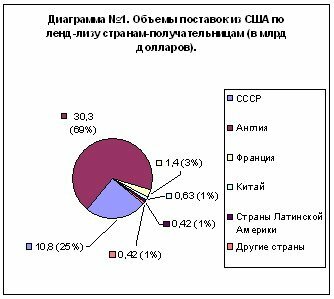 Lend-Lease deliveries in the USSR and their contribution to the victory
Lend-Lease deliveries in the USSR and their contribution to the victoryDuring the war, hundreds of thousands of tons of cargo were delivered to the USSR under Lend-Lease. The military historians (and, perhaps, all the others) are of the greatest interest, of course, with the allied military equipment - we will start with it. Lend-lease in the USSR was supplied from the USA: light M3A1 “Stuart” - 1676 pcs., Light M5 - 5 pcs., Light M24 - 2 pcs., Medium M3 “Grant” - 1386 pcs., Medium M4A2 “Sherman” (with a 75 mm gun) - 2007 pcs., Medium M4A2 (with a 76 mm gun) - 2095 pcs., Heavy M26 - 1 pc. From England: Valentine infantry - 2394 units, Matilda MkII infantry units - 918 units, Tetrarch light units - 20 units, Churchill heavy units - 301 units, Cromwell cruising units - 6 units. From Canada: Valentine - 1388. Total: 12199 tanks. In all, during the war years, 86,1 thousand tanks were delivered to the Soviet-German front.
Thus, Lend-Lease tanks accounted for 12,3% of the total number of tanks produced / supplied to the USSR in 1941-1945. In addition to tanks, ZSU / SPGs were also supplied to the USSR. ZSU: М15А1 - 100 pcs., М17 - 1000 pcs .; ACS: Т48 - 650 pcs., М18 - 5 pcs., М10 - 52 pcs. Total 1807 units were supplied. Total for the war in the USSR was produced and received 23,1 thousand units of ACS. Thus, the share of the ACS received by the USSR under the Lend-Lease of an ACS is equal to 7,8% of the total number of vehicles of this type obtained during the war. In addition to tanks and self-propelled guns, armored personnel carriers were also supplied to the USSR: British Universal Carrier - 2560 pcs. (including from Canada - 1348 pcs.) and American М2 - 342 pcs., М3 - 2 pcs., М5 - 421 pcs., М9 - 419 pcs., Т16 - 96 pcs., М31. ., LVT - 3340 pcs. Total: 5 units. Since no armored vehicles were produced in the USSR, the Lend-Lease cars were 7185% of the Soviet fleet of this technology. Criticism of the Lend-Lease often pay attention to the low quality of the armored vehicles supplied by the Allies. This criticism does have certain grounds, since the American and British tanks in TTX were often inferior to both the Soviet and German counterparts. Especially given the fact that the Allies usually supplied the USSR are not the best samples of their equipment. For example, the most advanced modifications of the Sherman (М100А4Е3 and Sherman Firefly) were not delivered to Russia.
Where is the best situation with Lend-Lease deliveries? aviation. In total, during the years of the war, 18 aircraft were delivered to the USSR, including from the USA: P-297 Tomahawk fighters - 40, P-247 Kitikhavk - 40, P-1887 AeroCobra - 39, P-4952 " Kingcobra "- 63, R-2400" Thunderbolt - 47; A-195 Boston bombers - 20, B-2771 Mitchell - 25; other types of aircraft - 861. 813 Spitfires and Hurricanes were delivered from England In total, the Soviet troops received 4171 thousand aircraft for the war, making the share of foreign equipment in the revenues of the domestic air fleet 138%, although the allies refused to supply the USSR with pride Air Force -. Strategic bombers B-13, B-17 and B-24, of which 29 thousand units were produced during the war And at the same time in such machines are most needed the Soviet Air Force..
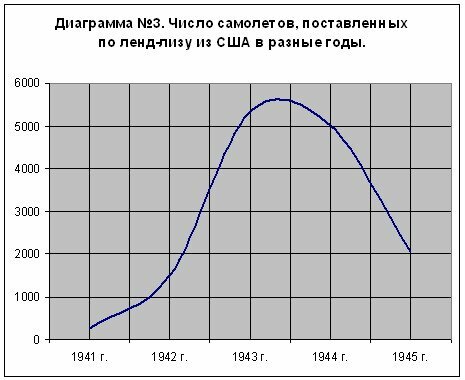 Under Lend-Lease, 8 thousand anti-aircraft and 5 thousand anti-tank guns were delivered. In total, the USSR received 38 thousand anti-aircraft units and 54 thousand anti-tank artillery. That is, the proportion of Lend-Lease in these types of weapons was respectively 21% and 9%. However, if we take all the Soviet guns and mortars as a whole (the receipts for the war are 526, 2 thousand), then the share of foreign guns in it will be only 2,7%.
Under Lend-Lease, 8 thousand anti-aircraft and 5 thousand anti-tank guns were delivered. In total, the USSR received 38 thousand anti-aircraft units and 54 thousand anti-tank artillery. That is, the proportion of Lend-Lease in these types of weapons was respectively 21% and 9%. However, if we take all the Soviet guns and mortars as a whole (the receipts for the war are 526, 2 thousand), then the share of foreign guns in it will be only 2,7%. During the years of the USSR, 202 torpedo boats, 28 escort ships, 55 minesweepers, 138 submarine hunters, 49 landing ships, 3 icebreaker, about 80 transport ships, and 30 tugboats were transferred to the USSR under Lend-Lease. Total about 580 ships. In total, the USSR during the war years received 2588 ships. That is, the proportion of Lend-Lease vehicles - 22,4%.
The most noticeable were Lend-Lease car supplies. Total Lend-Lease was delivered 480 thousand cars (of which 85% - from the US). This includes about 430 thousand freight (mainly US Studenbecker and REO US 6) and 50 thousand jeeps (Willys MB and Ford GPW). Moreover, the total revenues of cars on the Soviet-German front amounted to 744 thousand units, the share of Lend-lease vehicles in the Soviet fleet was 64%. In addition, 35 000 motorcycles were supplied from the USA.
But the supply of small weapons under the Lend-Lease were very modest: a total order of 150 000 units. Considering that the total receipts of small arms in the Red Army during the war amounted to 19,85 million units, the proportion of Lend-Lease weapons is approximately 0,75%.
During the war years in the USSR, 242,3 thousand tons of motor gasoline was supplied under Lend-Lease (2,7% of the total production and revenues of a / m gasoline in the USSR). The situation with aviation gasoline is as follows: 570 thousand tons of gasoline were supplied from the USA, and Britain and Canada - 533,5 thousand tons were supplied. In addition, 1483 thousand tons of light gasoline fractions were supplied from the USA, Britain and Canada. As a result of reforming, gasoline is produced from light gasoline fractions, the output of which is approximately equal to 80%. Thus, from 1483 thousand tons of fractions 1186 thousand tons of gasoline can be obtained. That is, the total supply of gasoline under Lend-Lease can be estimated at 2230 thousand tons. In the USSR, about 4750 thousand tons of aviation gasoline was produced during the war. Probably, this number also includes gasoline produced from the allies' factions. That is, the USSR production of gasoline from its own resources can be estimated at about 3350 thousand tons. Consequently, the share of Lend-Lease aviation fuel in the total amount of gasoline supplied and produced in the USSR is 40%.
622,1 thousand tons of railway rails were supplied to the USSR, which is equal to 36% of the total number of rails supplied and produced in the USSR. During the war 1900 locomotives were supplied, while in the USSR 1941 locomotives were produced for 1945-800 years, of which 1941 were 708. If we take the number of locomotives produced from June to the end of 1941 for a quarter of the total production, then the number of locomotives produced during the war will be approximately equal to 300 units. That is, the share of lend-lease locomotives in the total volume of locomotives produced and supplied in the USSR is approximately 72%. In addition, 11075 cars were supplied to the USSR. For comparison, in 1942-1945 in the USSR 1092 railway car was produced. During the war years, Lend-Lease supplied 318 thousand tons of explosives (of which the USA - 295,6 thousand tons), which is 36,6% of the total production and supplies of explosives to the USSR.
Under Lend-Lease, the Soviet Union received 328 thousand tons of aluminum. If you believe B. Sokolov (“The role of Lend-Lease in Soviet military efforts”), who estimated Soviet production of aluminum during the war at 263 thousand tons, the proportion of Lend-Lease aluminum from the total amount of aluminum produced and produced by the USSR will be 55%. Copper in the USSR was supplied 387 thousand tons - 45% of the total production and supply of this metal in the USSR. Under the Lend-Lease, the Union received 3606 thousand tons of tires - 30% of the total number of tires manufactured and supplied in the USSR. 610 thousand tons of sugar was supplied - 29,5%. Cotton: 108 m. Tons - 6%. During the war years, 38,1 thousand machine tools were supplied from the USA to the USSR, 6,5 thousand machines and the 104 press were supplied from Great Britain from the UK. During the war, the USSR produced 141 thous. M / r of machine tools and forging presses. Thus, the share of foreign machine tools in the domestic economy was 24%. The USSR also received 956,7 thousand miles of field telephone cable, 2,1 thousand miles of sea cable and 1,1 thousand miles of submarine cable. In addition, 35 800 radio stations, 5899 receivers and 348 locators, 15,5 million pairs of army boots, 5 million tons of food and so on were supplied by Lend-Lease in the USSR.
According to the data summarized in diagram No. 2, it can be seen that even in the main types of supplies, the share of Lend-Lease products in the total volume of production and supplies to the USSR does not exceed 28%. In general, the share of Lend-Lease products in the total volume of materials, equipment, foodstuffs, machinery, raw materials, etc. produced and supplied to the USSR. Usually estimated at 4%. In my opinion, this figure, in general, reflects the real state of affairs. Thus, it is possible with a certain degree of confidence to declare that the Lend-Lease did not have any decisive influence on the USSR’s ability to wage war. Yes, under the Lend-Lease supplied these types of equipment and materials, which accounted for most of the total production of such in the USSR. But would the lack of supply of these materials become critical? In my opinion, no. The USSR could easily redistribute production efforts in order to provide itself with everything necessary, including aluminum, copper, and locomotives. Could the USSR do without Lend-Lease? Yes, he could. But the question is, what would it cost him. Do not be a Lend-Lease, the USSR could go two ways to solve the problem of the shortage of those goods that were supplied by this Lend-Lease. The first way is just to close your eyes on this deficiency. As a result, there would be a shortage of cars, airplanes and a number of other vehicles and equipment in the army. Thus, the army would certainly have been weakened. The second option is to increase our own production of products supplied under Lend-Lease through the involvement of extra labor force in the production process. This force, respectively, could be taken only at the front, and thereby again weaken the army. Thus, when choosing any of these paths, the Red Army was the loser. As a result, we are dragging out war and unnecessary casualties on our part. In other words, Lend-Lease, though it did not have a decisive influence on the outcome of the war on the Eastern Front, but, nevertheless, saved hundreds of thousands of lives of Soviet citizens. And for that alone, Russia should be grateful to its allies.
Speaking about the role of Lend-Lease in the victory of the USSR, one should not forget about two more points. Firstly, the vast majority of machinery, equipment and materials were supplied to the USSR in 1943-1945. That is, after a turning point during the war. So, for example, in 1941, Lend-Lease delivered goods worth about $ 100 million, which amounted to less than 1% of the total supply. In 1942, this percentage was 27,6. Thus, more than 70% of Lend-Lease deliveries came in 1943-1945, and during the most terrible period of the war for the USSR, the help of the Allies was not too noticeable. As an example, in diagram No. 3 you can see how the number of aircraft delivered from the United States changed in 1941-1945. Cars are an even more telling example: as of April 30, 1944, only 215 thousand units were delivered. That is, more than half of the Lend-Lease cars were delivered to the USSR in the last year of the war. Secondly, far from all the equipment supplied under Lend-Lease was used by the army and fleet. For example, out of 202 torpedo boats delivered to the USSR, 118 did not have to take part in the hostilities of the Great Patriotic War, since they were put into operation after its completion. All 26 frigates received by the USSR also entered service only in the summer of 1945. A similar situation was observed with other types of equipment.
And finally, at the end of this part of the article is a small stone in the garden of Lend-Lease critics. Many of these critics emphasize the insufficiency of the supply of allies, supporting this by saying that the United States, with their level of production, could supply more. Indeed, the United States and Britain produced small arms 22 million units, and put the entire 150 000 thousand (0,68%). From the produced tanks, the Allies put the USSR 14%. The situation was even worse with cars: in the United States during the war years, about 5 million cars were produced, and about 450 thousand were supplied to the USSR — less than 10%. And so on. However, this approach is certainly wrong. The fact is that supplies to the USSR were not limited by the production capabilities of the allies, but by the tonnage of the available transport ships. And just with him the British and Americans had serious problems. The Allies simply physically did not have the number of transport vessels necessary to transport more cargo to the USSR.
Supply routes
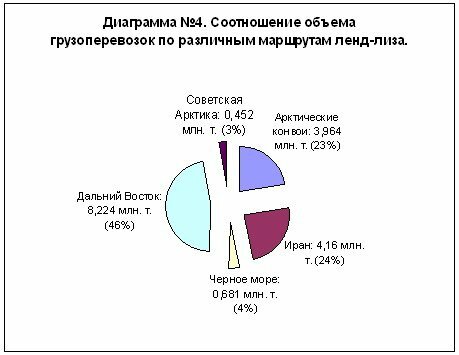 Lend-lease cargo got into the USSR by five routes: through the Arctic convoys to Murmansk, across the Black Sea, through Iran, through the Far East and through the Soviet Arctic. The most famous of these routes, of course, is Murmansk. The heroism of the sailors of the Arctic convoys has been praised in a variety of books and movies. It is probably for this reason that many of our fellow citizens had the false impression that the main supplies under Lend-Lease were sent to the USSR by the Arctic convoys. Such an opinion is pure delusion. On the diagram №4 you can see the ratio of the volume of freight traffic on various routes in long tons. As we can see, not only did most of the land-lease goods not pass through the Russian North, but this path was not even the main one, yielding to the Far East and Iran. One of the main reasons for this state of affairs was the danger of the northern route due to the activity of the Germans. On chart # XXNX you can see how effectively the Luftwaffe and Kriegsmarine acted on the Arctic convoys.
Lend-lease cargo got into the USSR by five routes: through the Arctic convoys to Murmansk, across the Black Sea, through Iran, through the Far East and through the Soviet Arctic. The most famous of these routes, of course, is Murmansk. The heroism of the sailors of the Arctic convoys has been praised in a variety of books and movies. It is probably for this reason that many of our fellow citizens had the false impression that the main supplies under Lend-Lease were sent to the USSR by the Arctic convoys. Such an opinion is pure delusion. On the diagram №4 you can see the ratio of the volume of freight traffic on various routes in long tons. As we can see, not only did most of the land-lease goods not pass through the Russian North, but this path was not even the main one, yielding to the Far East and Iran. One of the main reasons for this state of affairs was the danger of the northern route due to the activity of the Germans. On chart # XXNX you can see how effectively the Luftwaffe and Kriegsmarine acted on the Arctic convoys. The use of the trans-Iranian route became possible after the Soviet and British troops (from the north and the south respectively) entered Iranian territory, and on September 8 a peace agreement was signed between the USSR, Britain and Iran, along which British and Soviet troops were stationed in Persia. troops. From that moment, Iran began to be used for supplies to the USSR. Lend-lease cargo went to the ports of the northern end of the Persian Gulf: Basra, Khorramshahr, Abadan and Bandar-Shahpur. In these ports, aircraft and car assembly plants were set up. From these ports in the USSR, cargo went in two ways: by land through the Caucasus and by water through the Caspian Sea. However, the Trans-Iranian route, as well as the Arctic convoys, had its drawbacks: first, it was too long (the route from New York to the coast of Iran around the South African cape of Good Hope took about 75 days, and then it took time for the cargo to pass on Iran and the Caucasus or the Caspian). Secondly, German aviation hampered navigation in the Caspian Sea, and only in October and November sank and damaged the 32 ship with cargo, and the Caucasus was not the most peaceful place: only in 1941-1943 years in the North Caucasus 963 gangster groups were eliminated with a total 17513 person. In 1945, the Black Sea route was used instead of the Iranian route for deliveries.
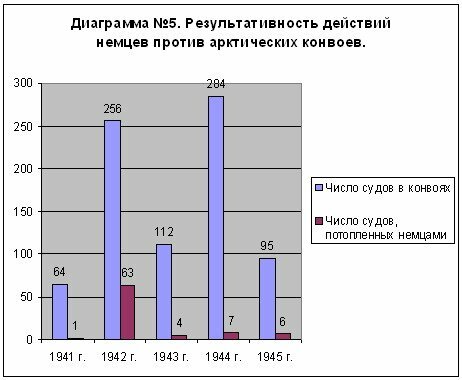 However, the safest and most convenient route was the Pacific route from Alaska to the Far East (46% of the total supply) or through the Arctic Ocean to the Arctic ports (3%). Basically, Lend-Lease shipments were delivered to the USSR from the USA, by itself, by sea. However, most of the aircraft moved from Alaska to the USSR on their own (AlSib). However, even in this way there were difficulties, this time already connected with Japan. In 1941 - 1944, the Japanese detained 178 of the Soviet ships, some of which were Kamenets-Podolsky, Ingul and Nogin transports on 2 and more than a month. The 8 vessels — the transports Krechet, Svirstroy, Maikop, Perekop, Angarstroy, Peacock Vinogradov, Lazo, and Simferopol — were sunk by the Japanese. The Ashgabat, Kolkhoznik, and Kiev transports were sunk by unidentified submarines, and about 10 ships died under unexplained circumstances.
However, the safest and most convenient route was the Pacific route from Alaska to the Far East (46% of the total supply) or through the Arctic Ocean to the Arctic ports (3%). Basically, Lend-Lease shipments were delivered to the USSR from the USA, by itself, by sea. However, most of the aircraft moved from Alaska to the USSR on their own (AlSib). However, even in this way there were difficulties, this time already connected with Japan. In 1941 - 1944, the Japanese detained 178 of the Soviet ships, some of which were Kamenets-Podolsky, Ingul and Nogin transports on 2 and more than a month. The 8 vessels — the transports Krechet, Svirstroy, Maikop, Perekop, Angarstroy, Peacock Vinogradov, Lazo, and Simferopol — were sunk by the Japanese. The Ashgabat, Kolkhoznik, and Kiev transports were sunk by unidentified submarines, and about 10 ships died under unexplained circumstances. Lend-Lease Payment
This is perhaps the main topic for speculations of people trying to somehow denigrate the program of Lend-Lease. Most of them consider it their indispensable duty to declare that the USSR supposedly paid for all the goods supplied by Lend-Lease. Of course, this is nothing more than a delusion (or a conscious lie). Neither the USSR nor any other countries that received assistance under the Lend-Lease program, in accordance with the law on Lend-Lease during the war, did not pay a single cent for this assistance. Moreover, as already stated at the beginning of the article, they were not obliged to pay even after the war for those materials, equipment, weapons and ammunition that were consumed during the war. It was necessary to pay only for what remained after the war in one piece and could be used by the recipient countries. Thus, there was no Lend-Lease payment during the war. Another thing is that the USSR actually sent various goods to the USA (including 320 thousand tons of chrome ore, 32 thousand tons of manganese ore, as well as gold, platinum, wood). This was done in the framework of the reverse lend-lease program. In addition, the same program included free repair of American ships in Russian ports and other services. Unfortunately, I was not able to find the total amount of goods and services provided by the Allies within the framework of reverse lend-lease. The only source I found claims that this sum amounted to 2,2 million dollars. However, personally, I am not sure about the authenticity of this data. However, they may well be considered as a lower limit. The upper limit in this case will be the sum of several hundred million dollars. Anyway, the share of reverse lend-lease in the total lend-lease trade between the USSR and the allies will not exceed 3-4%. For comparison, the amount of reverse Lend-Lease from the UK to the US is 6,8 billion dollars, which is 18,3% of the total exchange of goods and services between these countries.
So, no Lend-Lease payment took place during the war. The Americans provided the bill to the recipient countries only after the war. The volume of UK debt to the United States was $ 4.33 billion, to Canada - $ 1.19 billion. The last payment of $ 83.25 million (in favor of the United States) and $ 22.7 million (Canada) was made on December 29 2006. The amount of debt of China was determined in 180 million dollars, and this debt has not yet been repaid. The French paid off the US 28 in May 1946, giving the States a number of trade preferences.
The debt of the USSR was determined in 1947 in the amount of 2,6 billion, but already in 1948, this amount was reduced to 1,3 billion. However, the USSR refused to pay. The refusal was followed in response to new US concessions: in 1951, the amount of debt was again revised and this time amounted to 800 million. The agreement on the procedure for repayment of debt on lend-lease payments between the USSR and the USA was signed only on October 18 of the year 1972 (the amount of debt was again reduced, this time to 722 million dollars; the maturity date is 2001 year), and the USSR agreed to this agreement only on condition that it was granted a loan from the Export-Import Bank. In 1973, the USSR made two payments totaling $ 48 million, but then stopped paying due to the introduction of the Jackson-Vanik amendment to the Soviet-American trade agreement 1974 in 1972. In June, 1990, during negotiations between the presidents of the United States and the USSR, the parties returned to a discussion of the debt. A new final maturity date was set - 2030 of the year, and the amount - 674 million. At the moment, Russia for the supply of Lend-Lease owes US 100 million dollars.
Other types of supplies
Lend-Lease was the only significant type of allied supplies of the USSR. However, not the only one in principle. Before the adoption of the Lend-Lease program, the United States and Britain supplied the USSR with equipment and materials for cash. However, the size of these supplies were quite small. For example, from July to October 1941, the United States supplied the USSR with a total of $ 29 million in cargo. In addition, deliveries to the USSR on account of long-term loans were envisaged in Britain. Moreover, these deliveries continued even after the adoption of the Lend-Lease program.
Do not forget about the many charitable foundations created to raise funds in favor of the USSR throughout the world. Assisted the USSR and private individuals. Moreover, such assistance came even from Africa and the Middle East. For example, the Russian Patriotic Group was established in Beirut, and the Russian Medical Assistance Society of Russia was created in Congo .. Iranian merchant Rakhimyan Ghulam Huseyn sent tons of dried grapes to 3 in Stalingrad. And merchants Yusuf Gafuriki and Mamed Zhdalidi handed over 285 cattle heads to the USSR.
Literature
1. Ivanyan E. A. History of the USA. M.: Bustard, 2006.
2. / A Brief History of the US / Under. ed. I. A. Alyabyev, E. V. Vysotskaya, T. R. Jum, S. M. Zaitsev, N. P. Zotnikov, V. N. Tsvetkov. Minsk: Harvest, 2003.
3. Shirokorad A. B. Far Eastern Final. M .: AST: Transyzdatknig, 2005.
4. Schofield B. Arctic convoys. Northern naval battles in World War II. M .: Tsentrpoligraf, 2003.
5. Temirov Yu. T., Donets A.S. War. M .: Eksmo, 2005.
6. Stettinius E. Lend-Lease - a weapon of victory (http://militera.lib.ru/memo/usa/stettinius/index.html).
7. Morozov A. The Anti-Hitler Coalition during the Second World War. The role of Lend-Lease in the victory over the common enemy (http://militera.lib.ru/pub/morozov/index.html).
8. Russia and the USSR in the wars of the XX century. Loss of the armed forces / Under total. ed. G. F. Krivosheev. (http://www.rus-sky.org/history/library/w/)
9. National economy of the USSR in the Great Patriotic War. Statistical collection. ( http://tashv.nm.ru/)
10. Wikipedia materials. ( http://wiki.lipetsk.ru/index.php/%D0%9B%D0...BB%D0%B8%D0%B7)
11. Lend-Lease: how it was. (http://www.flb.ru/info/38833.html)
12. Aviation Lend-Lease in the USSR in 1941-1945 ( http://www.deol.ru/manclub/war/lendl.htm)
13. Soviet Lend-Lease Historiography ( http://www.alsib.irk.ru/sb1_6.htm)
14. What we know and what we do not know about the Great Patriotic War (http://mrk-kprf-spb.narod.ru/skorohod.htm#11)
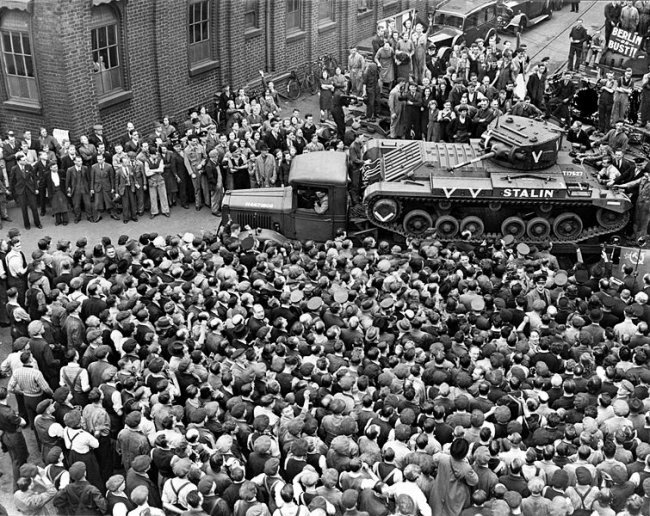
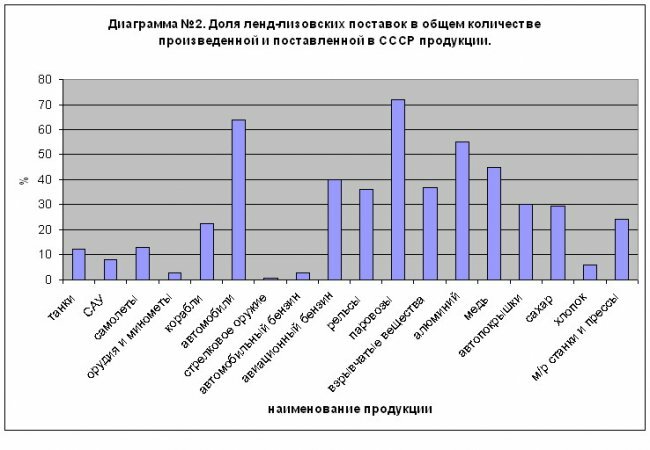
Information